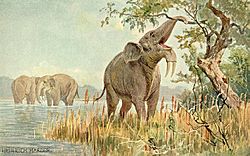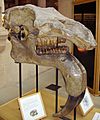Deinotherium facts for kids
Quick facts for kids DeinotheriumTemporal range: Middle Miocene – Early Pleistocene
|
|
|---|---|
 |
|
| Illustration of Deinotherium | |
| Scientific classification | |
| Kingdom: | |
| Phylum: | |
| Class: | |
| Order: | |
| Suborder: |
†Deinotheroidea
|
| Family: |
†Deinotheriidae
|
| Genus: |
†Deinotherium
Kaup, 1829
|
Deinotherium was a huge, ancient animal that looked a bit like an elephant, but with some very unique features! It lived millions of years ago, from the Miocene to the Pleistocene epochs. Imagine an elephant, but even bigger, with a shorter trunk and strange tusks that curved downwards from its lower jaw.
Contents
Meet Deinotherium: The Giant Ancient Elephant Relative
Deinotherium was a massive proboscidean, which is the group of animals that includes modern elephants. These amazing creatures were much larger than today's elephants. They roamed parts of Africa, Asia, and Europe for millions of years.
What Made Deinotherium Special?
The most noticeable things about Deinotherium were its short trunk and its unusual tusks. Unlike modern elephants whose tusks curve upwards, Deinotherium's tusks grew downwards from its lower jaw. This unique look has made scientists wonder for a long time how these ancient giants used their strange tusks.
How Did Deinotherium Use Its Tusks?
Scientists have debated a lot about the purpose of Deinotherium's downward-curving tusks. Here are some of the ideas:
- Digging for food: They might have used their tusks to dig in the soil. This would help them find tasty underground plant parts like roots and tubers.
- Pulling down branches: Another idea is that they used their tusks to pull down tree branches. This would make it easier to snap them off and reach the leaves high up.
- Stripping bark: They might also have used their tusks to strip soft bark from tree trunks. Bark can be a good source of food for large plant-eating animals.
Where Did Deinotherium Live?
Several different types, or species, of Deinotherium existed. Their fossils have been found across a wide area, including parts of Africa, Asia, and Europe. Interestingly, some Deinotherium fossils have been discovered in the same places where remains of early human relatives, called hominids, have also been found in Africa. This means they lived in the same areas at similar times!
Images for kids
See also
 In Spanish: Deinotherium para niños
In Spanish: Deinotherium para niños





